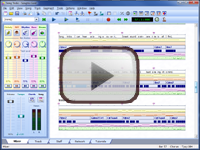(2.9) Major Scale Note Names
Notice how the C♯ Major scale is almost identical to the C Major scale, except that every note is sharp.

This seems logical, and yet it contains the notes E♯ and B♯. These don't seem to exist, because we know that there is only a one semitone interval between the notes E and F, and between the notes B and C.
In fact, E♯ is simply another name for F natural, and B♯ another name for C natural. The names are written like this because of the golden rule above introduced earlier - each note letter must be represented once in the scale.
For the C♯ Major scale, the letters F and C are needed for the notes F♯ and C♯, but the letters E and B are spare. So E♯ is used for the third note, B♯ is used for the seventh note, and everything fits perfectly.
In a similar way, when necessary, C♭ is another name for B natural and F♭ is another name for E natural.
We see something even stranger if look at the notes of the G♯ Major scale.

The last note in this scale is pronounced F sharp sharp or F double sharp (in sheet music, the symbol x is used instead of ♯♯). This, as you might guess, is another name for the note G.
Double sharps and flats are perfectly legal, and often necessary to preserve the correct sequence of note letters in the scale. They do look strange though, and in practice eccentric keys like this are not often used.
Most ChordWizard products allow you to select how notes are named within the workspace. There are up to four different methods.
-Strict naming works according to the rules described above.
-Single Symbol naming converts double sharps and flats to the next natural note up or down, to reduce visual complexity.
-Simplified naming is the same as Single Symbol naming, but it also simplifies F♭ to E, E♯ to F, C♭ to B and B♯ to C.
-Default naming simply uses your preferred default names for each sharp or flat note.











